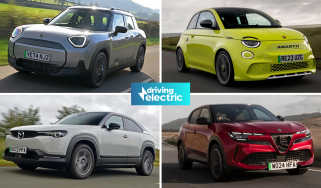Top 10 electric cars with the biggest boots 2024
Looking for an EV with plenty of space? We give a rundown of the electric cars with the biggest boots
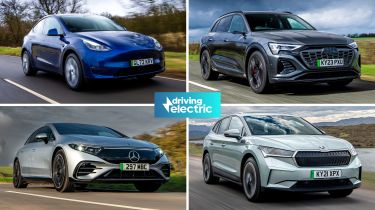
When electric cars were in their infancy, early adopters often had to make compromises in terms of practicality. That was because many were built on platforms originally designed for combustion-engined cars, meaning the electric drive components had to be fitted in where they could, and this often resulted in a loss of luggage space.
These days, however, most electric cars are based on purpose-built platforms, so designers have much more control over whereabouts in the car to place all the bits and pieces necessary to make an electric car tick. As you’d hope, this has brought about a serious increase in the practicality of your average electric car. That’s great news, but which electric models should you be considering if load-carrying capacity is one of your main priorities? Well, let our handy guide to the electric cars with the biggest boots enlighten you.
A couple of caveats before we begin. Firstly, we’ve omitted anything that’s based on a van. Why? Because the list would be completely dominated by them due to their huge floor to ceiling rear cargo spaces. Van-based MPVs are extremely practical but they are a somewhat specialist choice for private buyers in the electric car space. We considered this approach to be more helpful. If you are interested in how these models perform, then take a look at the ‘honourable mentions’ section at the bottom of the page to get an idea of how much boot space a converted van can offer.
Secondly, the boot space figures we’re quoting are manufacturer-supplied ones, and refer to the car’s capacity with five seats in place. So, if the car we’re talking about is a seven-seater (which some are), bear in mind that this will be with seats six and seven folded away.
Thirdly, we’re going strictly off the manufacturer-supplied numbers here, but beware that these boot capacity figures aren’t always what they seem. There are often variations in how different manufacturers measure boot space, because the process isn’t 100% standardised (as you’ll see), and this can have quite an effect on the final figure quoted.
For example, Jaguar publishes two figures for its I-Pace, each of which uses a different measuring method, and there’s more than 150 litres of difference between them! This being the case, please bear in mind that the comparisons here might not be coming from a completely level playing field.
You’ll notice that almost all the cars on this list are – predictably – large and expensive. If you’re just after a car with sufficient space for the average family, why not check out our list of the best electric family cars? We also have a list of the best electric cars, if you’re after the best EVs on sale, according to us. Also, if you’re after an electric car with generous boot space at a more affordable price point, check out the ‘honourable mentions’ section at the bottom of the page.
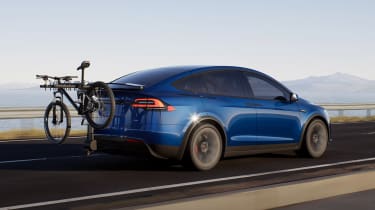
1. Tesla Model X – 1050 litres
It might be one of the oldest cars on our list, but the Model X – in five-seater form – still takes the prize for the biggest boot in an EV. That’s probably because Tesla has never built a combustion-engined car, meaning the Model X gets its own purpose-built EV underpinnings. The car might have had a bit of extra help from a spot of creative accounting, too; Tesla is very cagey about the precise measuring method used to come up with the figure of 1,050 litres (after all, since when has Elon Musk paid any attention to convention?), and the figure is staggeringly high, so we’d be surprised if the formula used is the same as with the other cars on this list. Regardless, you can rest assured, the boot in the Model X is huge – just maybe not quite as huge as the figures suggest.
Read our full Tesla Model X review to find out more.
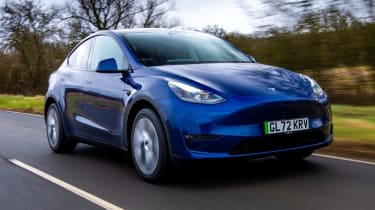
2. Tesla Model Y – 854 litres
We’d apply the same note of caution to the Tesla Model Y’s boot figure of 854 litres, and in addition, we know that this figure includes the space up to the car’s sloped rear window and roof, rather than to the parcel shelf, which is how most other manufacturers do it. So again, while the figures may be slightly misleading, there’s no doubting that the Model Y’s boot is huge. With this in mind, it’s no wonder why it’s the world’s best-selling electric car.
Read our full Tesla Model Y review to find out more.
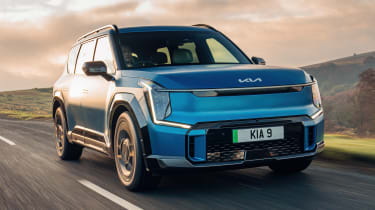
3. Kia EV9 – 828 litres
Our DrivingElectric Car of the Year for 2024, the Kia EV9 is a thoroughly impressive EV that also happens to have a pretty massive boot. Available in either six or seven seat configurations, Kia’s flagship offers 333 litres of space with all three rows of seats in place – the same as many superminis like the Peugeot E-208. Don’t need to bring the whole family? Fold down the rearmost row – electronically via the press of a button, of course – and you get a much larger 828 litres of load area to play with. Plus if that wasn’t enough, single-motor cars also benefit from a 50-litre ‘frunk’ under the bonnet, which is ideal for storing your charging cables.
Read our full Kia EV9 review to find out more.
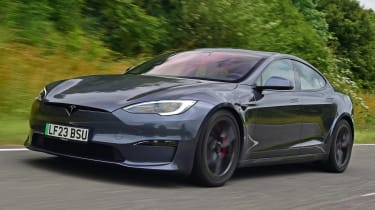
4. Tesla Model S – 744 litres
Rounding out Tesla’s domination of the top half of this list – likely for reasons similar to those already mentioned – is the Model S. Tesla’s large electric saloon car does have an undeniably large boot, however, and if you go for the range-topping Plaid version, it also happens to be one of the fastest accelerating cars on the planet. Before you run off and order one, though, remember that Tesla only offers the Model S in left-hand-drive form nowadays, so make sure you can live with that compromise.
Read our full Tesla Model S review to find out more.
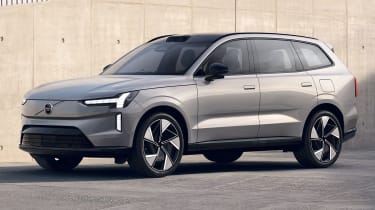
5. Volvo EX90 – 655 litres
Already on sale but with first deliveries not expected until early 2025, the new Volvo EX90 can’t come fast enough for EV buyers after a huge boot. This super-smart seven-seat SUV has an enormous loadspace of 655 litres with five of its seven seats in place, and even when all the seats are occupied, there’s still an impressive 310 litres, which is enough to trouble some superminis. There are a great many reasons why we can see this car appealing to eco-conscious (and deep-pocketed) family car buyers, and this incredible level of practicality is one of the main ones.
Read our full Volvo EX90 breakdown to find out more.
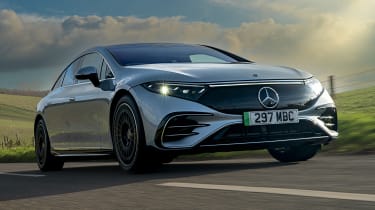
6. Mercedes EQS – 610 litres
Merc’s new all-electric limousine has a huge boot measuring 610 litres, and its hatchback-style opening also makes it easier to access your luggage than in most luxury saloon rivals. Compare this to the more traditional bootlid and 500-litre capacity of the BMW i7 and the EQS is pretty much untouchable amongst its peers for cargo-carrying ability. It’s not quite so generous on passenger space, though, which is arguably more important for most luxury limo customers, its impressive technology and longest range of any electric car more than makes up for that.
Read our full Mercedes EQS review to find out more.
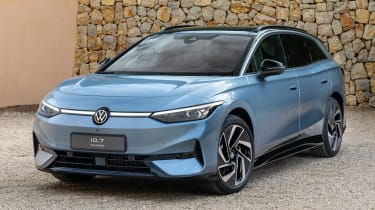
7. Volkswagen ID.7 Tourer – 605 litres
Essentially an estate version of the already-practical Volkswagen ID.7 fastback-cum-saloon, the Tourer gets a much higher roofline to boost storage space even further. Thanks to the adjustable backrests on the second row, the ID.7 Tourer offers up to 605 litres of stowage space, while still offering seating for five; push the rear seats back into the reclined position and this figure reduces to a slightly smaller, yet still roomy 565 litres. Elsewhere, the ID.7 is loaded with handy cubbyholes, all lined with felt to avoid items rattling, while top models are capable of up to 426 miles on a single charge – all ideal features if you plan to take the VW on longer adventures.
Read our full Volkswagen ID.7 review to find out more.
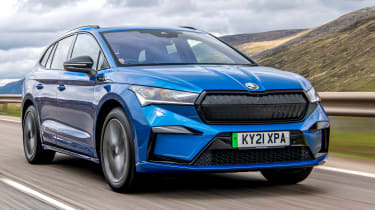
8. Skoda Enyaq – 585 litres
The Enyaq is by far and away the most affordable car on our list, so it’s perhaps even more impressive that it manages to beat out much more expensive options when it comes to load-carrying capacity. The Enyaq’s 585-litre boot is huge by any standard, and the passenger space you get is just as cavernous, while a whole host of ingenious touches (umbrellas hidden in the doors, anyone?) make family life that little bit simpler. You’ll also appreciate the electric Skoda’s impressive quality and grown-up driving manners.
Read our full Skoda Enyaq review to find out more.
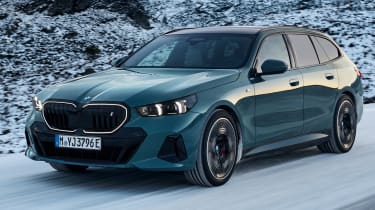
9. BMW i5 Touring – 570 litres
The first electric BMW 5 Series is now also available as an estate, providing an ideal compromise for those looking for something spacious that’s also enjoyable to drive. The BMW i5 Touring ‘only’ has 80 litres more boot space than the saloon, but this still results in a roomy 570-litre load area, which can be expanded to a cavernous 1,700 litres by folding the rear seats down. Unfortunately, the i5 Touring doesn’t retain the old petrol powered 5 Series’ opening rear windscreen, which made it easy to load smaller items. However, it does get a range of up to 344 miles, BMW’s latest infotainment system and an illuminated version of the brand’s iconic kidney grille – we’ll let you decide whether that last one is a good thing or not.
Read our full BMW i5 review to find out more.
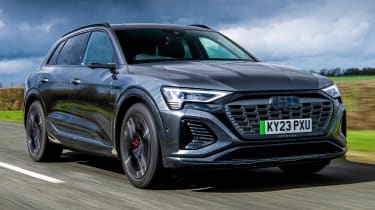
10. Audi Q8 E-Tron – 569 litres
Remember earlier when we said that these boot volume figures aren’t always what they seem? Well, the Q8 e-tron is a great example. Once known as simply the ‘Audi e-tron’, the Q8 was previously quoted to have a boot capacity of 660 litres, which would’ve put it much further up this list. Post-facelift and renaming, however, that figure has since dropped to 569 litres. We asked Audi what had changed, and the answer was… absolutely nothing, except the method used to measure it. Even so, the Q8 e-tron still has one of the biggest boots in the class, both on paper and in real life.
Read our full Audi Q8 e-tron review to find out more.
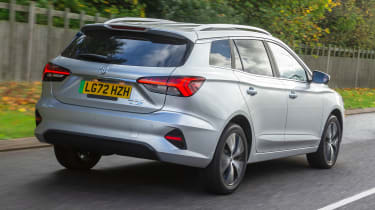
Honourable Mentions
As we mentioned earlier, we’re very aware that this list is full of cars that are very large and very expensive, so what if you need an electric car with a big boot, but have a more modest budget? Well fear not, because you do have options.
Estate cars are always a great place to start when looking for generous boot space, but at present, there aren’t many electric estate cars out there. In fact, we can only think of two right now: the MG 5 EV with its 479-litre boot, and the Porsche Taycan Cross Turismo/Sport Turismo with 446 litres, but the latter is hardly an affordable option. However, it won’t be long before the electric versions of the Peugeot 308 SW and Vauxhall Astra Estate arrive, and these will have 548 litres and 516 litres, respectively.
SUVs are the more popular choice, though, and there are plenty of electric ones to choose from. The Volkswagen ID.4 provides 543 litres of cargo space, while the Hyundai Ioniq 5 isn’t far behind with 527 litres. Both are more affordable options than the BMW iX3, which gives you 510 litres, while the Kia EV6 also does pretty well with 490 litres.
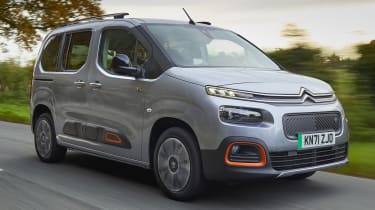
As mentioned, there’s also a whole variety of van-based passenger cars on offer if you’re one of the few people that doesn’t mind their car looking like a commercial vehicle. The Citroen e-Berlingo, Peugeot E-Rifter and Vauxhall Combo Life Electric all provide impressive cargo capacity in a reasonably compact footprint, while the same manufacturers also offer the e-SpaceTourer, E-Traveller and Vivaro Life Electric, respectively, for people who need even more space, plus seating for up to nine. If you’re after something a tad posher there’s also the Mercedes EQV. The precise amount of cargo space you get with these varies according to a vast variety of factors, but rest assured that they’re all enormous.
And then there’s the super-cool VW ID. Buzz. We did consider including this on our main list due to the fact that it’s based on the same platform as the ID.4 SUV we mentioned earlier, yet it offers a staggering 1,121 litres of boot space. However, given it also comes in van form, it contravened our rules. Nevertheless, the ID. Buzz is still very deserving of a mention here.

